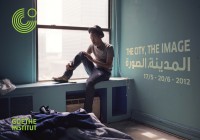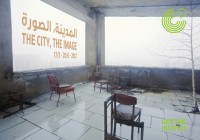The City | The Image (2012)
This exhibition is brought to Ramallah by Goethe-Institut and in partner with Sakakini Cultural Centre, Riwaq, Danish House, Beit Aneeseh and JCU.
The City | The Image is a platform in which we intend to question the city, discuss it, to think through it, and to play around with it. The platform is based on a touring photography exhibition that is produced by Ostkreuz a German photography agency under the title The City: Becoming and Decaying. The body of work looks into different cities around the world focusing on the life of the city itself, how it is born, how it lives and then; like us the humans who live in it, how it decays and eventually dies.
-----
What we ultimately have before us is a portrait of a city that brings together all cities, a city that stretches back before memory and extends beyond our imagination. A city that seems timeless, and yet, at each and every moment, is precisely the city we humans have created. People enable cities to grow and decline. They come and flee, build and destroy, press towards the center and remain on the outskirts. Seek community, and stand alone-people who want to fulfill their aspirations. They have created a place for this: it is called the city.
Marcus Jauer
I enjoy walking around in the city, it is the best way to explore places, it allows one to look attentively into details; little things that grow shyly in the cracks of buildings and roads, small events that happen accidentally here and there, the new shops that open, the old shops that close, people moving, people standing, people sitting, noises, sounds, cars, building, colours, empty plots… slowness is how one can notice these fast happening moments, to grasp the rapid changes, and the ever-continuous movement that happens in our urban environment. Photography is that total slowness, it is the freezing of time, a capture of a moment, an intervention in the speed of the city and slice of its life course.
But what is this photograph that we have of the city? How does it construct the way we imagine it? How does this slice of a city become the city that we know?
The occasion for this comprehensive stocktaking is the new record levels of global urbanization reached in 2008. Now, for the first time in history, more people live in cities than in rural areas. Every day, more than 190,000 people worldwide move to cities—two every second. This inexorable process has been underway since the onset of industrialization in the nineteenth century, but has reached hitherto unprecedented levels in recent decades in the developing world. There are currently 25 megacities that are home to more than ten million people. Simultaneously, many existing cities around the world are decaying, shrinking, or being destroyed.
The exhibition has been expended into a series of events that will take place in different locations in the city of Ramallah. But the idea isn’t to create a program about Ramallah the city, but rather to discuss how the city -in its global meaning- is represented through images, films, literature and performances.
Manila, Las Vegas, Tangiers, Cairo, Berlin, Beirut, Detroit, Gaza, Chernobyl, and many other cities will be hosted in Ramallah during the period of three weeks between 17/5 till 7/6, where different locations and venues will be the spaces in which these cities will be discussed and presented.
This photo exhibition that is brought to Palestine by Goethe-Institut, will be partially exhibited at Sakakini center where Manila photos will be shown, where as at the French-German Cultural Centre, three openings will take place in the duration of the exhibition during to the lack of exhibition spaces that can host such a big photo exhibition, so we decided to use Goethe-Institut’s basement for the first time as an exhibition space. This would be an opportunity to explore a new space in Ramallah.
The series of events will consist of film screenings showing different practices and relations within the city, from graffiti to architecture, and from loving the city to hating it. Also a series of presentations, talks and walks by young urban planners and architects who have been questioning the environments that they are living in, looking into the notion of public space, and the technologies that produce the urban realities. Two performances will take place on issues of sound, story telling, and memory.
----
Organised and curated by Yazan Khalili.
participants among others:
Nura AlKhalili
Shuruq Harb
Samiha and Dina Khalil
Tala Abu Rahmeh
Andreas Brück
Eyad Issa
Muna Dajani
Aya Hijazi
Sahar Qawasmi

